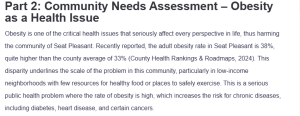Part 2: Community Needs Assessment – Obesity as a Health Issue
Obesity is one of the critical health issues that seriously affect every perspective in life, thus harming the community of Seat Pleasant. Recently reported, the adult obesity rate in Seat Pleasant is 38%, quite higher than the county average of 33% (County Health Rankings & Roadmaps, 2024). This disparity underlines the scale of the problem in this community, particularly in low-income neighborhoods with few resources for healthy food or places to safely exercise. This is a serious public health problem where the rate of obesity is high, which increases the risk for chronic diseases, including diabetes, heart disease, and certain cancers.
The problem of obesity has persisted in Seat Pleasant for over fifteen years, a sign that this health problem is deeply rooted and continuous. Despite several intervention efforts by local health agencies and community organizations, the rate has not shown much improvement. Patterns of obesity can even be seen to transcend generations since multiple age groups within families get affected, thus further exacerbating the problem. For this reason, the trend has been such that the Department of Health, in 2023, depicted that the obesity epidemic became intergenerational in nature, thus making it more and more difficult to break this vicious cycle of poor health outcomes. The situation at hand compels one to find effective and sustainable solutions to tackle the manifestations and the underlying causes linked with the problem of obesity.
The scope and impact of obesity in Seat Pleasant extend well beyond individual health concerns. The condition seems to affect every age set residing within the community; however, it has a high prevalence among African American populations. This, in turn, contributes to higher rates of diabetes and heart diseases that are already prevalent in the area. Some of the economic costs associated with the obesity crisis include increased health costs and a decline in productivity, hence pressuring community resources already scarce. As the health system gets stretched, so do families and individuals with the financial and emotional costs involved in managing diseases resulting from obesity.
The trend of obesity is also worrisome in Seat Pleasant due to the inequalities in food availability and lack of funds. Seat Pleasant can be defined as a food desert since the city has many limitations on accessing healthy and affordable foods. Without such accessibility, it remains hard for individuals to adopt healthy dietary behaviors since people continue practicing poor diet choices that are casually linked to obesity. Besides, safe places for physical activity are hardly accessible, further limiting the residents’ possibilities for regular exercise. These barriers disproportionately affect low-income and minority populations-groups already burdened by a large part of health disparities. The Maryland Department of Health (2023) declares that structural barriers are one of the leading causes that have allowed community obesity to persist at high levels.
Addressing obesity in Seat Pleasant will be multi-factorial, tending both to immediate health risks and deeper social determinants of health. Community-wide strategies should stress increasing access to healthy food, promoting opportunities for physical activity, and mitigating economic barriers to healthier lifestyle options. Targeted interventions are to be designed in such a way that the requirements of the most affected populations, especially low-income and minority groups, are satisfied in efforts toward ensuring health equity. The intersection of frequency, duration, scope, and equity clearly shows that obesity in Seat Pleasant is not an individual health problem but a complex challenge that requires a multi-faceted response from the community.
References
County Health Rankings & Roadmaps. (2024). Prince George’s County health data. https://www.countyhealthrankings.org/health-data/maryland/prince-georges?year=2024
Maryland Department of Health. (2023). State health improvement process. https://health.maryland.gov/pophealth/Documents/Maryland’s%20State%20Health%20Improvement%20Process.pdf
ORDER A PLAGIARISM-FREE PAPER HERE
We’ll write everything from scratch
Question
Community Research
Group Assignments – You will work with your assigned group to create a community needs assessment and a program plan.
- 1. First read Understanding and Describing the Community in the community toolbox (click on the link below):
- 2. Your group will need to choose one community in Prince George’s County to evaluate for your needs assessment.
- 3. Please review the example reports and links below. You can also use other reputable and scholarly sources.
- The links and reports above provide you with a starting point to gather information that you may need to answer the questions below.
- Please use additional resources to complete this assignment, please be sure to use reputable and scholarly sources. Wikipedia does not count as a reputable source.
- 4. Write an assessment in essay form about the community that your group has chosen. Only one report is necessary to submit for the group. Your group will identify the following based on your chosen zip code: ( SEAT PLEASANT in Prince George’s County and we are talking about OBESITY)
- 8. What are the resources in the community?
- 9. Describe the access to healthcare for the community?
- 10. What are the languages spoken in the community?
APA Style Requirement: Your essay should be written in APA format with at least 3-5 references. Please review the APA style folder.

Part 2: Community Needs Assessment – Obesity as a Health Issue
Part 2 – Community Needs Assessment:
- Identifying the Issue (50 points)
- Choose a health issue based on your community needs assessment. See the link below to assist you with this assignment:
- You will examine the following and write your paper in essay form following APA guidelines.
- Does the problem occur too frequently (frequency)?
- Has the problem lasted for a while (duration)?
- How does the problem affect the community (scope, or range)?
- Has the problem deprived the community of legal or moral rights (equity)?
- Please submit 2 separate files

